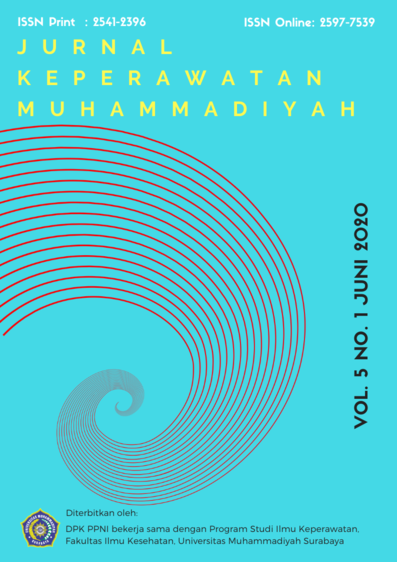Konsumsi, Status Gizi, Dan Profil Kimiawi-Klinis Mahasiswa UKSW Etnis Dayak Ngaju
DOI:
https://doi.org/10.30651/jkm.v5i1.4241Keywords:
Dayak Ngaju, Nutritional Status, ConsumptionsAbstract
Background: Nutrition issues in students mostly happen is a life changes phase that affected by lifestyle, so it could affected the behavior that tend to be unhealthy such as smoking, alcohol consumption, hyper-consumption, lack of physical activities and sleepless. This Unhealthy lifestyle potentially caused disease such as metabolic disorders. Therefore this research aim to find out the consumptions, nutritional status and chemical clinical profile and it correlation between nutritional status, anthropometry with chemical/clinical variable in UKSW students with Dayak ngaju ethnic background. This research used cross sectional observational design. Method: The number of respondents were 30 dayak ngaju ethnic students who lived in Salatiga. Data collection techniques using anthropometry measurements, chemical/clinical examination. Food frequency and food recall. Results: The result of anthropometry measurement and metabolic the 30 students showed, underweight 1 respondent (3,3 %), overweight 4 respondent (13,3%) low diastolic pressure (33,3 %), uric acid levels of 30 students is normal (100 %). 3 students with high cholesterol levels (10 %) and 6 students with high momentary glucose levels (20 %). Students nutritional intake using food recall 24 hours showed average energy consumption ±1527.44 kcal, protein ±51.09 gr, Fat ±46.27 gr, carbohydrate ±238.63 gr. Fulfillment of nutrient intake by category adequacy mostly fit in either category, but there were respondents who fall into the category of medium and light the deficit of protein (10%; 0% of respondents), carbohydrate (3.3%; 3.3% of respondents). The Pearson correlation test shows that there is a correlation between cholesterol and supraliaca with a p-value of 0.002 (p≤0.05).References
Choi, HK., Gary C. (2007). Coffe, Tea, and Caffeine Consumption and Serum Uric Acid Level: The Third National Health and Nutrition Examination Survey. Arthritis and Rheumatism (Arthritis Care and Research). American College of Rheumatology, 57 (5) : 816- 821
Kemenkes. (2016). Profil Kesehatan Indonesia 2016. Jakarta: Kemenkes, Hal 198-200.
Lazzeri, G., Casorelli, A., Giallombardo, D., Grasso, A., Guidoni, C., Menoni, E., Giacchi, M. (2006). Nutritional Surveillance in Tuscany: Maternal Perception of Nutritional Status of 8-9 Y-Old School-Children. Journal of Preventive Medicine And Hygiene, 47: 16-21
Maharani, DS., Triandhini, R.L.N.K., Karwur, F.F. (2018). Resiko Kosumsi, status Gizi dan Risiko Metabolik Mahasiwa Asal Pegunungan Tinggi Papua Di Salatiga Jawa, Tengah. Skripsi Fakultas Kedokteran dan Kesehatan, Universitas Kristen Satya Wacana.
Rasmada, sada., Triyanti., Indrawani, Yvonne M., Sartika, RAD. (2012). Asupan Gizi dan
Mengantuk pada Mahasiswa. Jurnal Kesehatan Masyarakat Nasional, 7(03), 99-104
Riset Kesehatan Dasar (Riskesdes). (2013). Laporan Hasil
Riset Kesehatan Dasar 2013. Badan Litbangkes, Depkes RI, 2013. Jakarta, Hal 71-81
Riset Kesehatan Dasar (Riskesdas) (2018). Badan Penelitian dan Pengembangan Kesehatan
Kementerian RI tahun 2018, Hal 61-94.
Risnaningsih, Rina dan Oktia Woro. (2008). “Kebiasaan Makan Fast Food, Konsumsi Serat dan Status Obesitas Pada Remaja Putriâ€. KEMAS 3,185-195.
SIRKENAS. (2016). Survei Indikator Kesehatan Nasional. Jakarta: Badan Penelitian. Pengembangan Kesehatan Kementerian Kesehatan RI.
https://labdata.litbang.depkes.go.id/riset-badan-litbangkes/menu-riskesnas/menu rikus/422-sirk-2016. Diakses Pada Tanggal 28 November 2019
Sulistyoningsih, H. (2010). Gizi Untuk Kesehatan Ibu dan Anak. Yogyakarta: Graha Ilmu. Hal 235-237
Downloads
Published
Issue
Section
License
- Penulis tetap memegang hak atas karyanya dan memberikan hak publikasi pertama kepada jurnal ini yang secara simultan karya tersebut dilisensikan di bawah:Â Creative Commons Attribution-ShareAlike 4.0 International (CC BY-SA 4.0)













